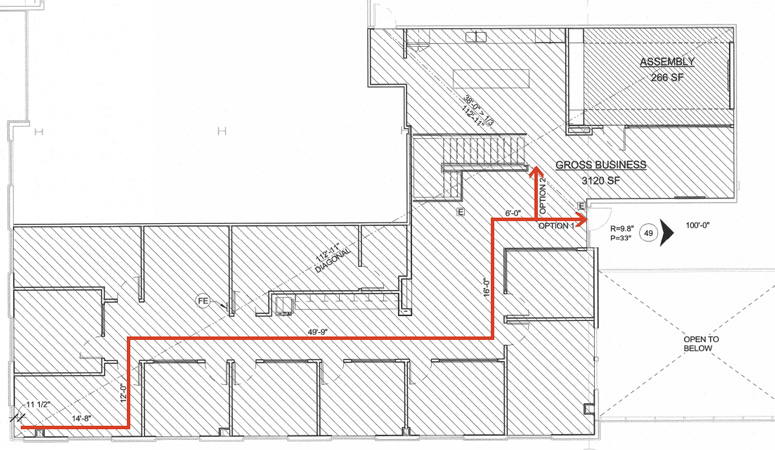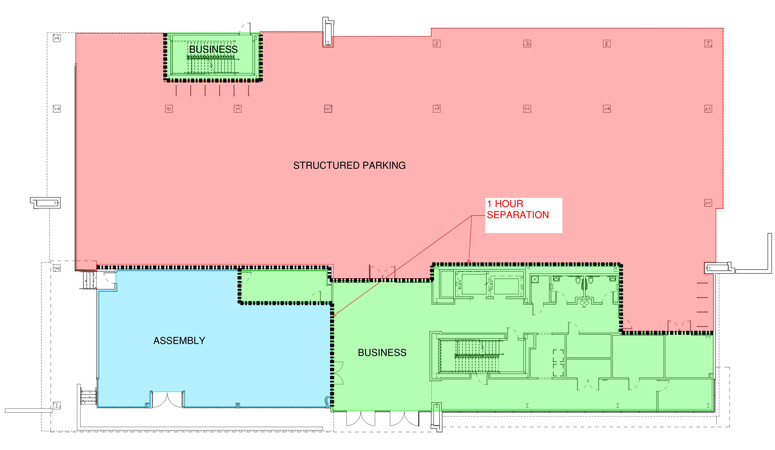Did you know that offices are the least regulated type of building from a building code perspective? It’s not to say that an office’s owner can completely disregard building codes and regulations, but there are numerous factors to consider. Despite the fewer number of office related codes in place, it’s best to think about the codes and restrictions early in the process of developing a new office environment to avoid expensive hiccups down the road. Here are a few to consider, based on our experience:
Remodel vs New Build
The International Code Council (ICC) releases an updated series of code books every three years, which means regulations are constantly changing, which makes it almost impossible for all buildings to be up to today’s current code. The regulations are a bit more lenient code-wise for existing buildings than new construction. The code recognizes that the building was up to code when it was built, and it does not require an owner to bring all aspects of the building up to the current code.
For example, a building erected in the 1980s may have difference specifications for the width and height of a stairwell, or the handrails may be a little bit different than what would be required for a new construction project. But, because the code (in general) assumes the stairwell complied with the code that was in effect at the time it was built, it offers some flexibility in the requirements.
This does change, however, if any work will be done on the part of the building in which the code is outdated. Take the stairs example again: if the design involves making changes to certain things in the stairwell, the city may require the stairwell to be 100% brought up to today’s code. If nothing is going to be done to the stairs, (for example, the owner will keep the handrails, guardrails, etc.) then updates wouldn’t need to be made to match the current code. But if the plan was to replace the guardrails and the handrails, then the building code now says the entire stairwell must be brought into current code. If the design planned is not making the situation worse, as in still complying with the original code, then requirements can be flexible. Whereas in a ground up/new construction project, everything will need to comply to the most recent code requirements.
Exits & ADA Requirements
There are a few items that will always need to comply with the current codes regardless if the project is a remodel or new build: exits and ADA requirements. Generally, small tenants (49 occupants or fewer) only need one exit from the space, but the building code requires a certain amount of travel distance necessary for a person to get to a point in which they have a choice of two exits. Issues can arise with different jurisdictions having different opinions on how to measure that path of travel and how someone moves through the space. We had to work through this situation on a recent project where the jurisdiction required the path to an exit to be measured in right angles which required our team to add an additional exit to comply with the code.

ADA requirements must be met for all office environments and this will not be flexible on a remodel project. At the bare minimum the owner will need to provide an ADA compliant restroom and have a way for users to enter the space. For example, if work is being done on a building that was built in 1968, ADA wouldn’t have applied, therefore we have to make provisions within that tenant space to be as accessible as possible. One way would be to provide a single user toilet room. We actually dealt with a similar situation on a recent project where the existing toilet rooms were not ADA accessible and there was no way to modify them because it was technically infeasible due to load-bearing walls. The most efficient solution was to add a single unisex bathroom which then complied with ADA requirements.
Occupancies
An office environment is the least regulated occupancy type because occupants typically are familiar with their surroundings and will know the best way to exit in an emergency. However, the code requirements for these spaces can become more complicated if additional occupancy types come into play. It is easier than one would think for an office design to quickly turn into more than just one occupancy type. In a recent office environment project, our design evolved into one that included the office space, an assembly space and a parking garage. Adding these additional occupancy types complicates the code requirements because there are now different expectations on how occupants will respond in an emergency.
In this scenario, the code requires us to either separate these occupancies or do something extra to ensure occupants can exit the building in a reasonable amount of time. That meant we needed to make each different occupancy type separate from the others. We accomplished this by adding a one hour rated floor slab between the different types so each section would withstand a fire emergency for at least one hour and allow any occupants to safely exit the building.

Whether a project is a new build or remodel, single-tenant or multi-tenant space, it isn’t difficult to comply with today’s code requirements, but it is essential to have as much knowledge as possible up front and be sure to consider code requirements early on in the process as well as the use of the space. If the project begins before certain decisions are made, like ones that could affect the occupancy type of one or more tenant space, this could result in a myriad of issues that can be extremely costly to fix.
About the author:
Eirene Knott, MCP, CBO, CFM, has more than 20 years of experience working nationally with building and fire codes. She has written and presented code changes to clarify language in the code, as well as provided testimony on other proposed code changes. Prior to joining BRR, Eirene served as a Building Official, a Senior Plans Analyst and a Building Inspector. She has taught several codes-related courses at various conferences and the National Fire Academy. Email her.



